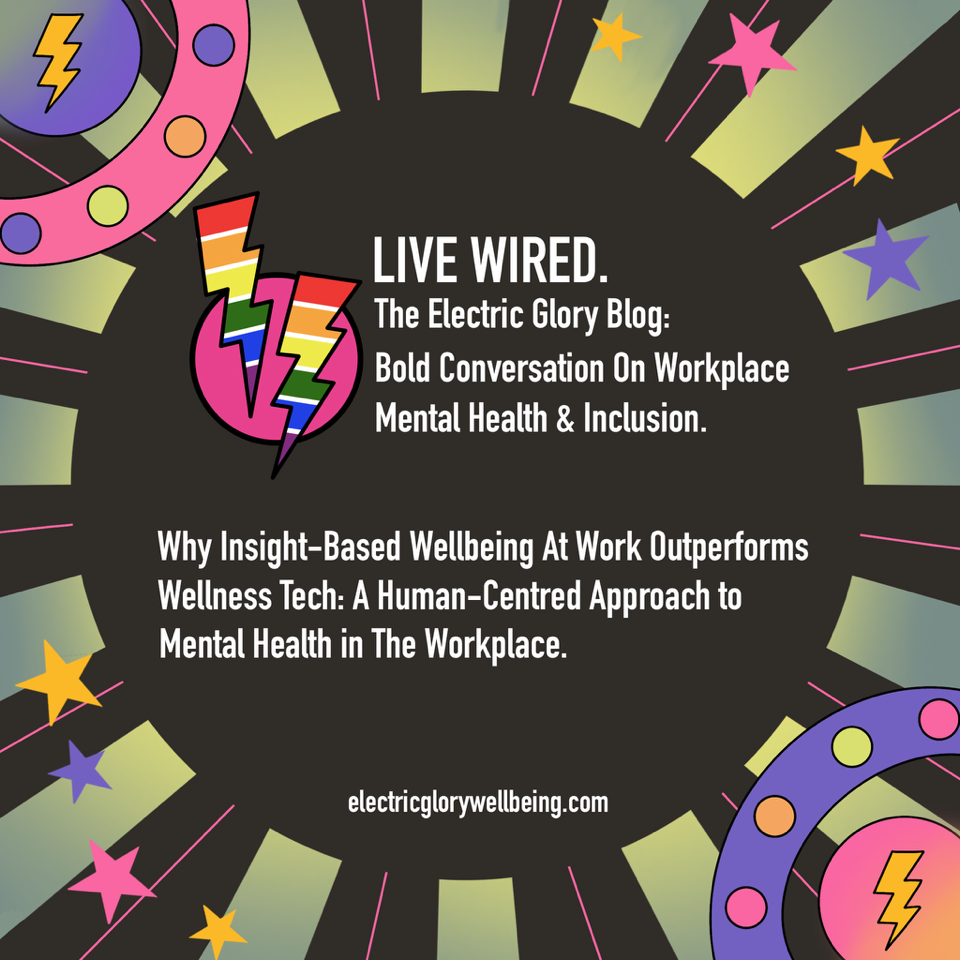Why Insight-Based Wellbeing at Work Outperforms Wellness Tech: A Human-Centred Approach to Mental Health in The Workplace.

Rachael Hill
Firstly, to clarify what I mean by insight-based employee wellbeing: This can be referred to as approaches that facilitate self-awareness, emotional reflection and adeeper understanding of one’s own behaviour and stress responses. Let’s say, human-led rather than algorithm-led!
Throughout my career spanning over a decade, my work has been grounded in one clear purpose: to support people with their mental health. Over the years, one recurring theme has stood out time and time again. People respond and engage best when connection and creativity are at the heart of the approach. Influence starts in human communication and connection. For example, can you pinpoint one moment in your life where something moved you emotionally, can remember how it made you feel? I bet it even changed things for you on some level. This is what I am referring to. Research suggests that memory retention can be compromised by listening to something passively, or in a disengaged state.
Of course, this isn’t to say that other methods aren’t valuable or necessary. Health services, digital resources have their place. But in my experience, lasting impact requires genuine engagement, and engagement is created through connection, emotional safety and creative expression. When people feel seen, heard and inspired – that’s when real change begins.
So how can Companies, CEOs and employees alike benefit from engagement-led wellbeing strategies? That’s exactly what this exploratory blog will unpack. Highlighting why human connection, creativity and emotional insight aren’t just ‘extras’ but essential investments for building a mentally healthy and high-performing workplace.
Why then, should you invest in employee wellbeing solutions that work?
In today’s fast-paced and hybrid workplaces, more employers are realising the value of evidence-based employee wellbeing programs. Burnout is now recognised by the World Health Organization as an occupational phenomenon, and it is on the rise. According to recent data, over 76% of employees say stress impacts their productivity, despite access to digital tools (World Health Organization, 2019; Deloitte, 2022). Not all solutions are created equal.
Effective workplace wellbeing strategies must also go beyond generic perks, perks may support people to feel valued however, wellbeing is felt, not just funded. To truly reduce burnout, Employers should include mental health support that engages the employees through empowerment, training and human-based intervention. Including access to resources that foster insight, reflection and connection. Keeping wellbeing visible and top of mind not only supports employee wellbeing but transforms workplace culture. You raise your companies’ standards. When employees feel seen, supported and psychologically safe, evidence shows that they’re more engaged, more productive and more likely to stay with you.
Companies that invest in proactive wellbeing initiatives see higher retention, reduced sick leave, improved morale and a stronger organisational culture. Not only are you caring, you’re creating a thriving, empowered workforce.
We are fortunate enough to live in a world where employers can choose from different approaches when it comes to supporting their employees with their wellbeing. Employee Assistance Programmes can take shape in many forms. Some organisations may choose tech-based support for example, Apps; AI prompts and dashboards. Or Insight-led support via human connection and resources, reflective practices, team days and coaching.
So, what’s available on the market for organisations to access? Subscription to mental health apps, mindfulness platforms, wearables and even chatbots! Digital employee wellbeing apps offer flexible, scalable and often cost-effective solutions that meet the needs of today’s hybrid and remote workforces. These tools provide on-demand access to mental health support. For employees who may feel uncomfortable speaking openly in a group or can’t attend in-person sessions, private, self-paced access can feel more accessible. Some digital platforms offer real-time analytics and engagement insights, making it easier to track usage trends and identify areas where additional support may be needed.
Despite the outlined benefits, studies show that fewer than 25% of employees regularly use employer-provided wellbeing apps (CIPD, 2022; Deloitte, 2022).Withso many apparent benefits, it’s fair to ask: why aren’t employees engaging with digital wellbeing platforms? The answer may lie in a modern phenomenon known as digital fatigue– also referred to as tech fatigue or screen fatigue. This growing issue describes the mental and physical exhaustion people experience from prolonged, often fragmented interaction with digital devices, apps and online platforms. In today’s fast-paced, hyper-connected work culture, many employees are already spending most of their day online. So when yet another wellbeing ‘solution’ is offered in the form of an app or screen, it may feel more like digital noise than meaningful support. We must ask ourselves: with so much constant input, how much information are we really absorbing? Are these tools genuinely engaging employees-or just keeping them occupied, distracted or even feeding digital dependency?
If we truly want to deliver employee wellbeing strategies that make a lasting impact, we need to move beyond the assumption that digital alone equals effective– an assumption that, while convenient, may fall flat in workplace settings. This shift can be challenging, especially in a landscape dominated by quick fixes and tech-driven solutions. But the truth is, access alone doesn’t create engagement. What does? Emotional resonance, relevance and connection. For wellbeing initiatives to truly land, they must feel meaningful to the people they’re designed for, not just another app to click through. In a time of digital overload, it’s connection not content that makes the difference. Connection may be cultivated through resources that prompt genuine reflection, spark curiosity and offer engaging, colourful, and creative experiences – tools that feel human, inviting, not overwhelming and different from the usual click-through content.
While traditional mental health approaches in the workplace often focus on clinical or reactive solutions, growing research shows that engaging, creative, and playfulwellbeing resources can have a profound and preventative impact. Tools like journaling prompts, vision boards, guided meditations, reflective games and expressive arts activities not only help individuals process but also foster psychological safety, emotional intelligence and team cohesion.
According to a 2021 report by the World Economic Forum, emotionally engaged and psychologically safe teams are more productive by up to 25%. Similarly, research by Gallup found that employees who feel connected, supported, and engaged at work experience less burnout and higher overall wellbeing—directly influencing retention and performance (World Economic Forum, 2021; Gallup, 2020).
Providing ready-made wellbeing kits and daily resources accessible to managers and teams empowers them to take initiative without requiring deep expertise. These tools act as catalysts for meaningful conversations, stress relief and proactive care, making wellbeing accessible, engaging and embedded in everyday culture –not just an afterthought or policy! Although of course policy is important too.
When companies invest in engagement-led, human-first wellbeing strategies, they see measurable results: lower absenteeism, stronger employee loyalty and enhanced team dynamics. Culture doesn’t change through apps alone –it transforms through shared experience, connection and emotionally intelligent leadership.
While digital employee wellbeing platforms are widely promoted as accessible solutions, the reality is often different. In my work supporting a diverse range of professionals including many neurodivergent employees, I’ve seen firsthand that engagement is the key to impact. Just because a mental health app exists doesn’t mean it’s being used. Throughout the years I have worked with people another common theme I have come across is that people often feel they are drowning in information starving for connection. Many employees face barriers to engaging with digital-only wellbeing strategies, such as information overload, screen fatigue or a lack of personal connection.
That’s why engaging your employees with creative wellbeing resource packs and regular employee check ins can make a real difference. These practical and enjoyable tools help teams access support in a way that feels meaningful and easy to engage with. Whether it’s through guided reflection prompts, visual tools, or personalised wellbeing kits, the goal is to make mental health support feel human, accessible and relevant. For organisations looking to improve workplace wellbeing and reduce burnout, investing in engagement-led mental health strategies leads to stronger outcomes and a more resilient workforce.
The Harvard Business Review reports that companies focusing on psychological safety and emotional literacy see a 40% improvement in team performance (Harvard Business Review, 2021).
What tech can’t teach is trust. trust, meaning & belonging highlights how insight-driven wellbeing fosters genuine connection at work, builds a culture of wellbeing and supports employee retention through authentic leadership.
By addressing the root causes of stress and burnout–not just symptoms–this approach enables long-term culture shifts, supported by practices like team days, wellbeing coaching, circle sharing and mental health-informed supervision. Insight also increases prefrontal cortex activation, linked to resilience and decision-making.
Technology is not ‘bad’ and offers us so much in this world however, it remains incomplete on its own. An effective, integrated wellbeing strategy combines hybrid wellbeing support blending digital tools with insight-led employee wellbeing resources.
From Insight Comes Impact. A truly sustainable wellbeing strategy must go beyond surface solutions. Insight-led, employee-centred wellbeing approaches are more human, more impactful and more aligned with how we feel, connect and growoffering preventative mental health support that empowers employees and fosters lasting cultural change and organisational performance.
Ready to create a wellbeing culture?
To discuss employee wellbeing solutions that work why not book a free 20-minute consultation with Rachael to explore tailored insight-based wellbeing experiences for your staff.
Contact Page: https://electricglorywellbeing.com/contact/
Email: hello@electricglorywellbeing.com
Call: 0755 7354 296
References:
CIPD (2022) Health and wellbeing at work: Survey report 2022. London: Chartered Institute of Personnel and Development. Available at: https://www.cipd.org/uk/knowledge/reports/health-wellbeing-work (Accessed: 5 July 2025).
Deloitte (2022) Mental health and staying in work: costs and inequalities in UK workplaces. Deloitte Insights.
World Economic Forum (2024) How to transform workplace mental health through a holistic approach. WEF Agenda.
World Economic Forum (2025) What companies can do to improve workplace wellbeing and why it matters. WEF Stories.
Gallup (2023) Workhuman–Gallup Research Finds Recognition at Work Bolsters Engagement and Shields Employees from Burnout. Business Wire.
Gallup (2022) ‘Employee burnout: the biggest myth’, Gallup Workplace, June 2022.
Gallup (2023) ‘Unhappy workers may reduce global GDP by as much as 9%’, Gallup.
Gallup (2021) The 38 Most Engaged Workplaces in the World Put People First.
DISCLAIMER: The writer is a Registered Mental health Nurse however, any information should not be considered as treatment or instructions & content should not be used in place of support.
The information contained on this page & in any third party websites referred to on this page is not intended nor implied to be a substitute for professional medical advice nor is it intended to be for medical diagnosis or treatment. Third party websites are not owned or controlled by Electric Glory and any individual may be able to access and post messages on them. Electric Glory is not responsible for the content or availability of these third party websites.
